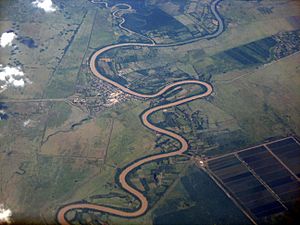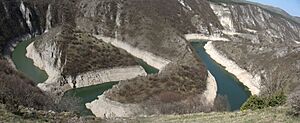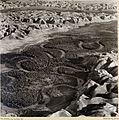Meander facts for kids


A meander is a natural curve or bend in a river. Imagine a river flowing like a snake across a flat area of land. Those snake-like curves are meanders! The shape and position of these curves slowly change over many years. The word "meander" actually comes from a river in an ancient land called Anatolia.
Rivers rarely flow in a perfectly straight line. This is because the water moves at different speeds in different places. Where the water moves slowly, it drops tiny bits of rock and dirt called sediment. Where it moves faster, it picks up and carries away sediment.
How Do Meanders Form?
Rivers are always changing their shape. Here's how meanders get their unique curves:
- Faster Water on the Outside: As a river flows around a slight bend, the water on the outside of the curve moves faster. This faster water has more energy.
- Erosion on the Outer Bank: The fast-moving water on the outside of the bend wears away the river bank. This process is called erosion. It happens through two main ways:
* Hydraulic action: The force of the water itself pushes and pulls at the bank. * Abrasion: The water carries rocks and sand, which then grind against the river bank, like sandpaper. * This erosion creates a steep bank, sometimes called a river cliff.
- Slower Water on the Inside: On the inside of the curve, the water moves much slower.
- Deposition on the Inner Bank: Because the water is slow, it loses energy and drops the sediment it was carrying. This sediment builds up, forming a gentle slope or a small beach.
This continuous process of erosion on the outer bank and deposition on the inner bank makes the bend in the river grow larger and larger over time. This is how a meander develops and becomes more noticeable.
From Meander to Oxbow Lake
Meanders don't stay the same forever. They keep changing and can eventually lead to the formation of a special type of lake:
- As a meander grows, its curves become more extreme. The two outer bends of the meander get closer and closer to each other.
- Eventually, during a flood or over a long period, the river might cut through the narrow piece of land between these two close bends. This creates a new, shorter path for the river.
- When the river takes this new, straighter path, the old meander bend is left behind. It gets cut off from the main river flow.
- This cut-off meander forms a U-shaped lake called an oxbow lake. The ends of the oxbow lake might slowly fill with sediment over time, eventually turning into a marshy area or dry land.
Related pages
Images for kids
-
The Jordan River, near the Dead Sea, 1937
-
Meanders on the River Clyde, Scotland
-
Concave bank and convex bank, Great Ouse Relief Channel, England.
-
Meander of the River Cuckmere in East Sussex, Southern England
-
Meander scars, oxbow lakes and abandoned meanders in the broad flood plain of the Rio Negro, Argentina. Photo from ISS.
-
The Rincon on Lake Powell in southern Utah. It is an incised cutoff (abandoned) meander.
-
Glen Canyon, US
-
Meanders, scroll-bars and oxbow lakes in the Songhua River
See also
 In Spanish: Meandro para niños
In Spanish: Meandro para niños










